lock Oldsmobile Aurora 1998 s Repair Manual
[x] Cancel search | Manufacturer: OLDSMOBILE, Model Year: 1998, Model line: Aurora, Model: Oldsmobile Aurora 1998Pages: 380, PDF Size: 19.75 MB
Page 240 of 380

If a Tire Goes Flat
It’s unusual for a tire to “blow out” while you’re driving,
especially if you maintain your tires properly. If air goes
out of a tire, it’s much more likely to leak out slowly.
But if you should ever have a “blowout,” here are a few
tips about what to expect and what
to do:
If a front tire fails, the flat tire will create a drag that
pulls the vehicle toward that side. Take your foot
off the
accelerator pedal and grip the steering wheel firmly.
Steer to maintain lane position, and then gently brake to
a stop well out of the traffic lane.
A rear blowout, particularly on a curve, acts much like a
skid and may require the same correction you’d use in a
skid.
In any rear blowout, remove your foot from the
accelerator pedal. Get the vehicle under control by
steering the way you want the vehicle to go. It may be
very bumpy and noisy, but you can still steer. Gently
brake to a stop
-- well off the road if possible.
If a tire goes flat, the next part shows how to use your
jacking equipment to change a flat tire safely.
Changing a Flat Tire
If a tire goes flat, avoid further tire and wheel damage
by driving slowly to
a level place. Turn on your hazard
warning flashers.
I-
Changing a tire can cause an injury. The vehicle
can slip
off the jack and roll over you or other
people. You and they could be badly injured.
Find a level place
to change your tire. To help
prevent the vehicle from moving:
1. Set the parking brake firmly.
2. Put the shift lever in PARK (P).
3. Turn off the engine.
To be even more certain the vehicle won’t move,
you can put blocks at the front and rear of the
tire farthest away from the one being changed.
That would be the tire on the other side of the
vehicle, at the opposite end.
5-24
Page 258 of 380
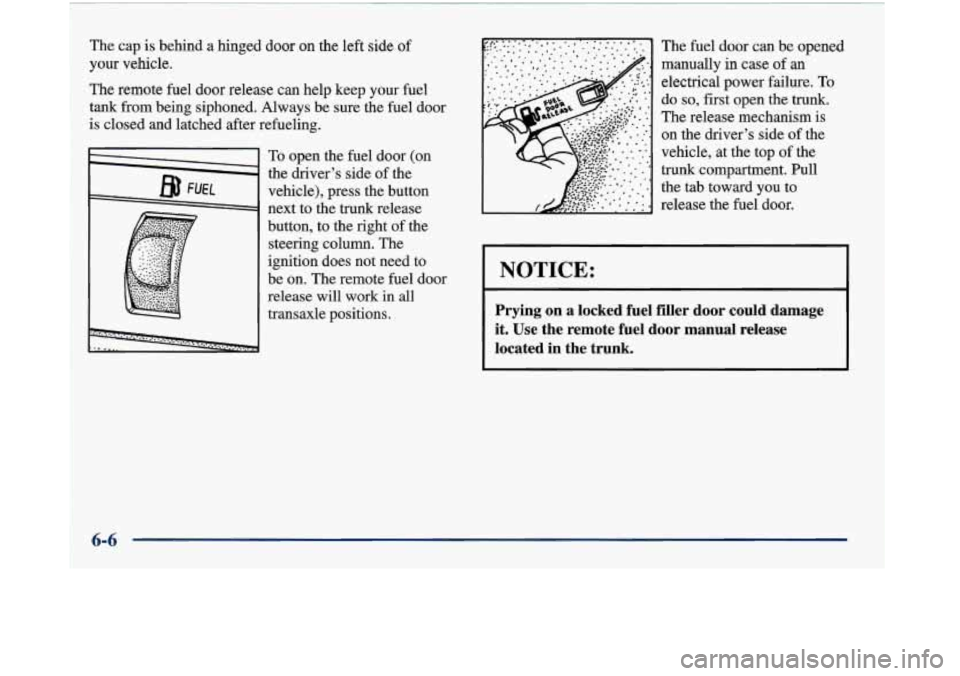
The cap is behind a hinged door on the left side of
your vehicle.
The remote fuel door release can help keep your fuel
tank from being siphoned. Always be sure the fuel door
is closed and latched after refueling.
To open the fuel door (on
the driver's side of the
vehicle), press the button
next to the trunk release
button, to the right of the
steering column. The
ignition does not need to
be
on. The remote fuel door
release will work in all
transaxle positions. The fuel
door can
be opened
manually in case
of an
electrical power failure. To
do so, first open the trunk.
The release mechanism is
on the driver's side
of the
vehicle, at the top
of the
trunk compartment. Pull
the tab toward you to
release the
fuel door.
NOTICE:
Prying on a locked fuel filler door could damage
it. Use the remote fuel door manual release
located
in the trunk.
6-6
Page 259 of 380
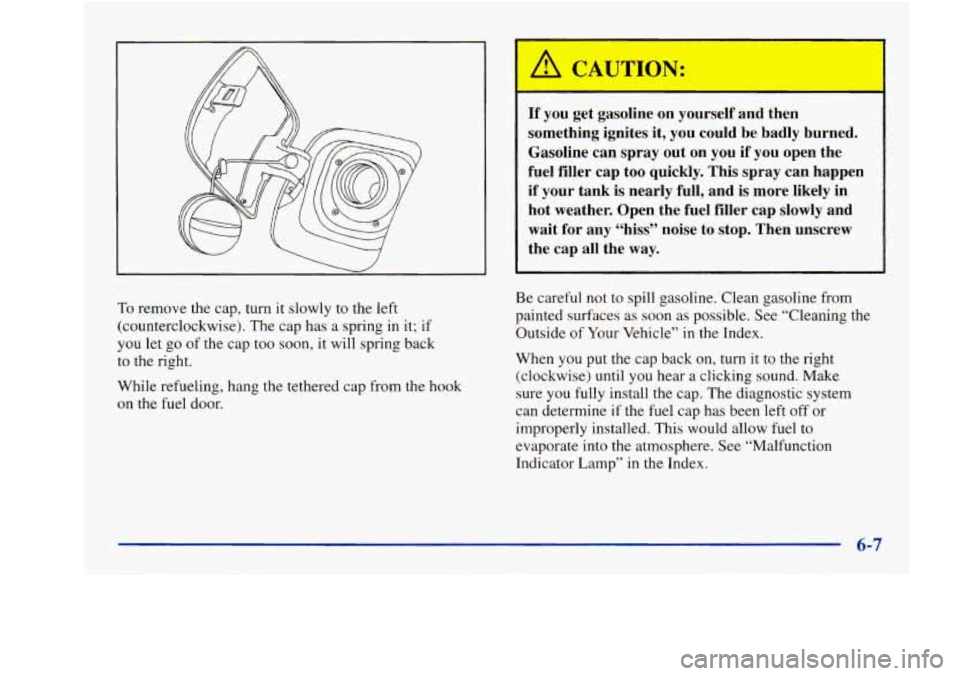
To remove the cap, turn it slowly to the left
(counterclockwise). The cap has a spring in it; if
you let go of the cap too soon, it will spring back
to the right.
While refueling, hang the tethered cap from the hook
on the fuel door.
If you get gasoline on yourself and then
something ignites
it, you could be badly burned.
Gasoline can spray out on you if you open the
fuel filler cap too quickly. This spray can happen
if your tank
is nearly full, and is more likely in
hot weather. Open the fuel filler cap slowly and
wait
for any “hiss” noise to stop. Then unscrew
the cap all the way.
Be careful not to spill gasoline. Clean gasoline from
painted surfaces as soon as possible. See “Cleaning the
Outside of Your Vehicle” in the Index.
When you put the cap back
on, turn it to the right
(clockwise) until you hear a clicking sound. Make
sure you fully install
the cap. The diagnostic system
can determine if the fuel cap has been left off or
improperly installed. This would allow fuel to
evaporate into the atmosphere. See “Malfunction
Indicator Lamp”
in the Index.
6-7
Page 287 of 380
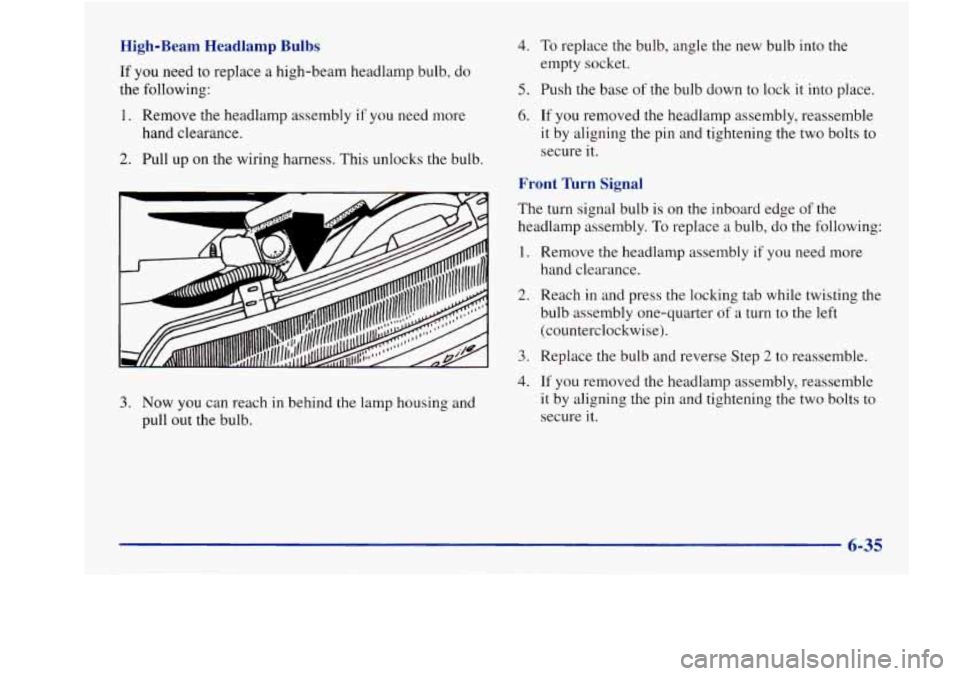
High-Beam Headlamp Bulbs
If you need to replace a high-beam headlamp bulb, do
the following:
1. Remove the headlamp assembly if you need more
hand clearance.
2. Pull up on the wiring harness. This unlocks the bulb.
1.
4. To replace the bulb, angle the new bulb into the
empty socket.
5. Push the base of the bulb down to lock it into place.
6. If you removed the headlamp assembly, reassemble
it by aligning the pin and tightening the two bolts
to
secure it.
Front Turn Signal
The turn signal bulb is on the inboard edge of the
headlamp assembly.
To replace a bulb, do the following:
2.
3.
4.
3. Now you can reach in behind the lamp housing and
pull out the bulb. Remove
the headlamp assembly
if you need more
hand clearance.
Reach in and press the locking tab while twisting the
bulb assembly one-quarter
of a turn to the left
(counterclockwise).
Replace the bulb and reverse Step
2 to reassemble.
If you removed the headlamp assembly, reassemble
it by aligning the pin and tightening
the two bolts to
secure it.
6-35
Page 293 of 380
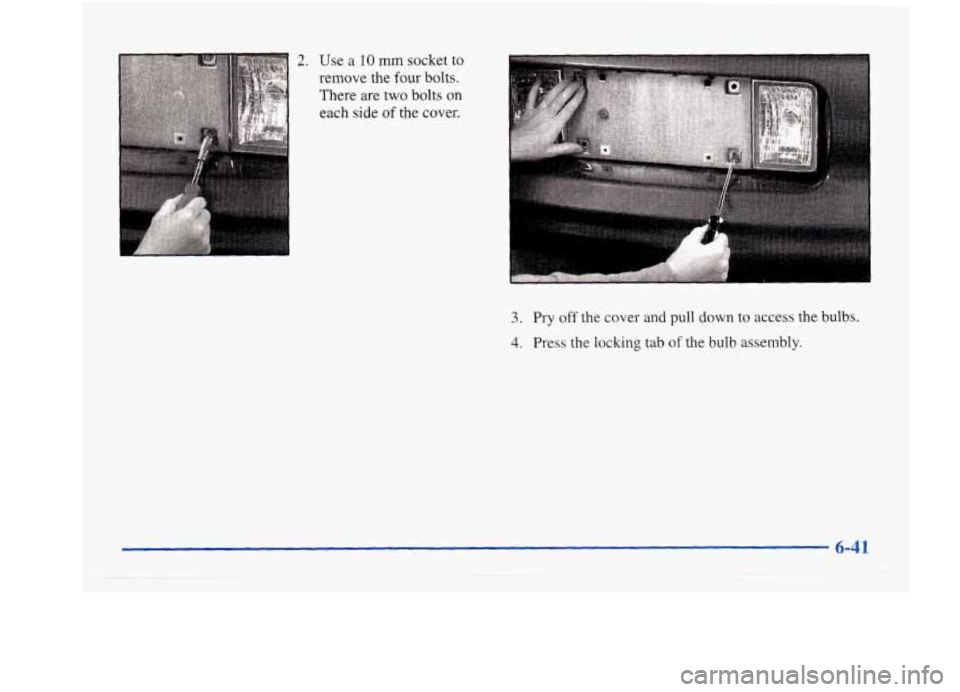
2. Use a 10 mm socket to
remove the four bolts.
There are two
bolts on
each side of the cover.
3. Pry off the cover and pull down to access the bulbs.
4. Press the locking tab of the bulb assembly.
6-41
Page 294 of 380

5. Twist the socket one-quarter of a turn to the left
(counterclockwise) and pull to remove.
6. Replace the bulb and reverse Steps 1 through 4 to
replace the assembly and tighten the bolts.
Interior Lamps
Front and Rear Reading Lamps
To change the bulbs in the front and rear reading lamps,
do the following:
1. Carefully insert a flat head screwdriver in the slot
2. Gently pry the lens cover away to expose the reading
3. Remove the bulb from its assembly and install a
between the lens
cover and molding.
lamp bulb. The lens cover should
pop off.
new bulb.
4. Snap the lens cover back in place.
6-42
Page 313 of 380
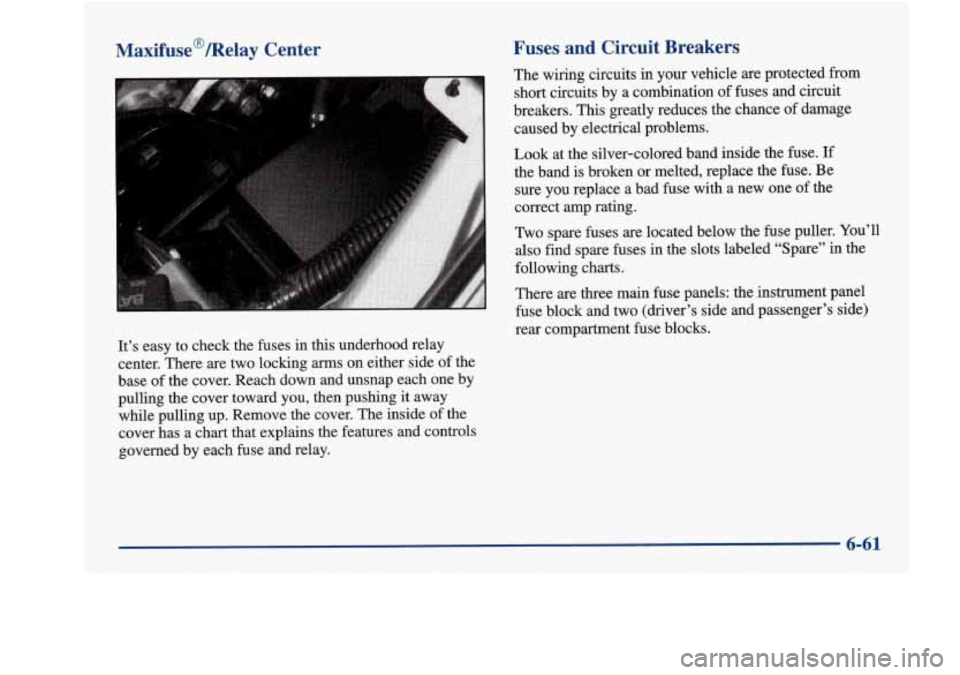
Maxifuse@/Relay Center
It’s easy to check the fuses in this underhood relay
center. There are two locking
arms on either side of the
base of the cover. Reach down and unsnap each one by
pulling the cover toward you, then pushing it away
while pulling up. Remove the cover. The inside of the
cover has a chart that explains the features and controls
governed by each fuse and relay.
Fuses and Circuit Breakers
The wiring circuits in your vehicle are protected from
short circuits by a combination
of fuses and circuit
breakers. This greatly reduces the chance
of damage
caused by electrical problems.
Look at the silver-colored band inside the fuse.
If
the band is broken or melted, replace the fuse. Be
sure you replace a bad fuse with a new one of the
correct amp rating.
1wo spare fuses are located below the fuse puller. You’ll
also find spare fuses in the slots labeled “Spare’’ in the
following charts.
There are three main fuse panels: the instrument panel
fuse block and two (driver’s side and passenger’s side)
rear compartment fuse blocks.
6-61
Page 314 of 380
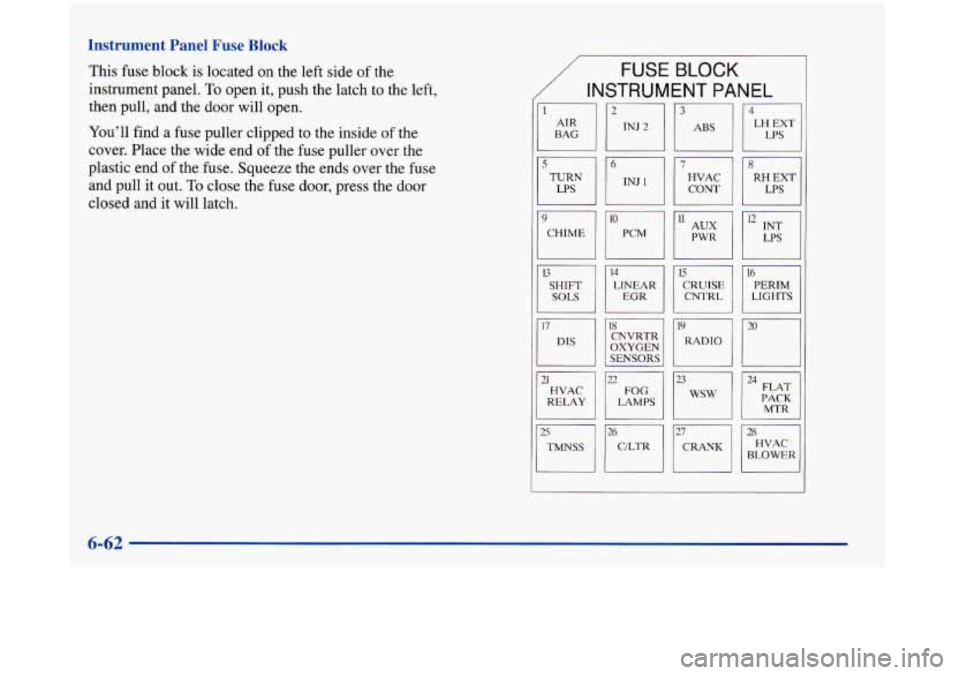
Instrument Panel Fuse Block
This fuse block is located on the left side of the
instrument panel.
To open it, push the latch to the left,
then pull, and the door will open.
You’ll find
a fuse puller clipped to the inside of the
cover. Place the wide end
of the fuse puller over the
plastic end
of the fuse. Squeeze the ends over the fuse
and pull it out. To close the fuse door, press the door
closed and it
will latch.
/ INSTRUMENT PANEL
11112113114
FUSE BLOCK
CHIME PCM PWR
CNTRL LIGHTS
I
RELAY LAMPS PACK MTR
mmJ2?CRANK/12fiHVhC BLOWER
Page 315 of 380

Fuse Usage
1 Supplemental Inflatable Restraint (Air Bag)
2
3
4
5
6
7
Injectors
Anti-Lock Brake System
Left Exterior Lamps Turn Signal Lamps
Injectors Climate Controls
8 Right Exterior Lamps
9 Chime (Ignition l), Memory Set
10 Powertrain Control Module, VATS
PASS-Key@II
11 Auxiliary Power
12
13
14
15
16
Interior Lamps Shift Solenoids
Linear
EGR
Cruise Control
Perimeter Lights
Fuse
17 18
19
20
21 22
23
24
25
26 27
28
Usage
Driver Information Center
Converter Oxygen Sensors
Radio Open
Climate Control Relay
Fog Lamps
Windshield Wipers
Flat Pack Motor
TMNSS
Cigarette Lighter
Crank,
Air Bag Module
Climate Control Blower
6-63
Page 317 of 380
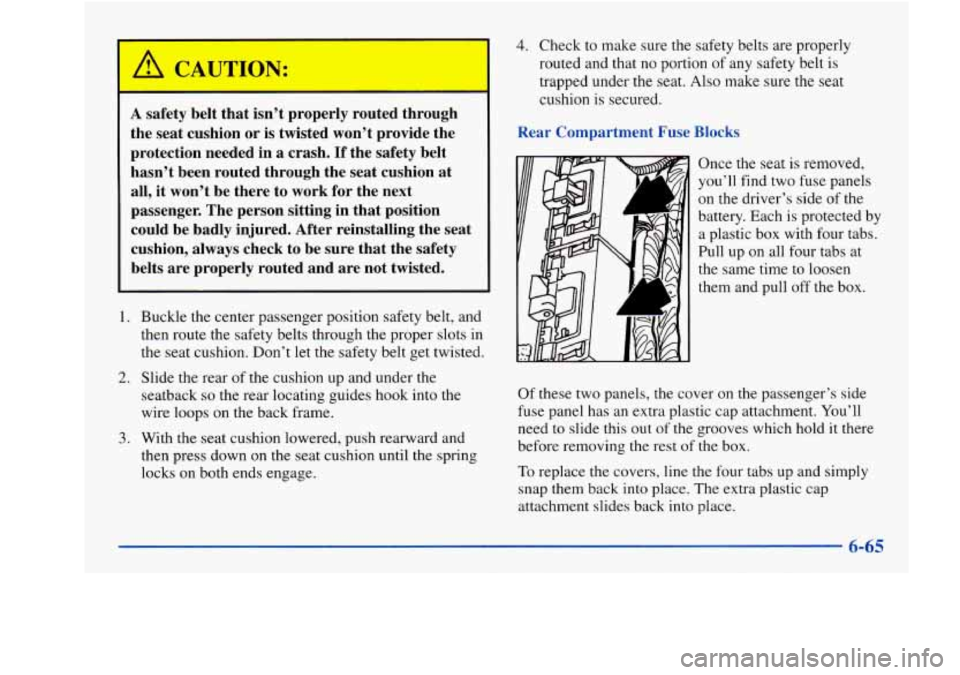
A safety belt that isn’t properly routed through
the seat cushion or is twisted won’t provide the
protection needed in a crash.
If the safety belt
hasn’t been routed through the seat cushion at
all, it won’t be there to work for the next
passenger.
The person sitting in that position
could be badly injured. After reinstalling the seat
cushion, always check to be sure that the safety
belts are properly routed and are not twisted.
1.
2.
3.
Buckle the center passenger position safety belt, and
then route the safety belts through the proper slots in
the seat cushion. Don’t let the safety belt get twisted.
Slide the rear of the cushion up and under the
seatback
so the rear locating guides hook into the
wire loops on the back frame.
With the seat cushion lowered, push rearward and
then press down on the seat cushion until the spring
locks on both ends engage.
4. Check to make sure the safety belts are properly
routed and that
no portion of any safety belt is
trapped under the seat. Also make sure the seat
cushion is secured.
Rear Compartment Fuse Blocks
Once the seat is removed,
you’ll find two
fuse panels
on the driver’s side of the
battery. Each is protected by
a plastic box with four tabs.
Pull up on all four tabs at
the same time to loosen
them and pull off the box.
Of these two panels, the cover on the passenger’s side
fuse panel has an extra plastic cap attachment. You’ll
need
to slide this out of the grooves which hold it there
before removing the rest of the box.
To replace the covers, line the four tabs up and simply
snap them back into place. The extra plastic cap
attachment slides back into place.
6-65